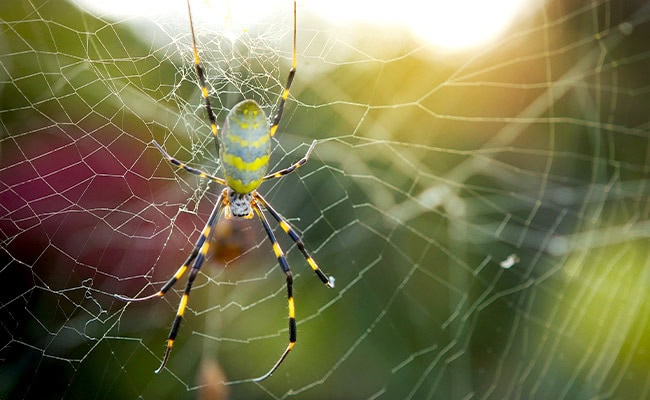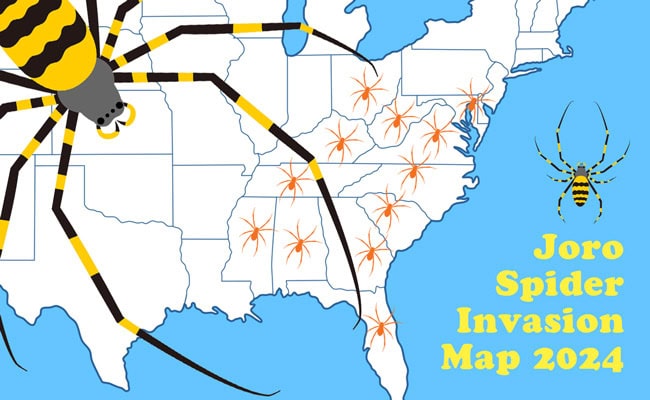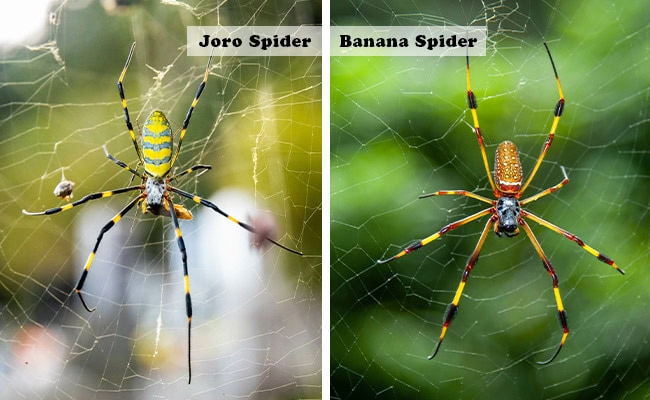Giant Joro Spider Invasion Map 2024 And FAQ

Will a new species of spider land in your state this summer? Check our Giant Joro Spider Invasion Map 2024 and frequently asked questions—including essential tips you need to know. Have any additional questions? Ask us in the comments section.
What are giant joro spiders?
Trichonephila clavata, also known as the joro spider or giant joro spider, is one of the largest of the orb-weaving spiders. Early in their life cycle, they are only about the size of a grain of sand, but adult joro spiders grow to have unusually large bodies and long legs.
Commonly spotted in August and September, full grown adult females can be up to four inches wide, with brightly hued blue-black and yellow stripes and a red marking on the underbelly. Like most spiders, adult male joro spiders are much smaller and duller compared to their female counterparts.
The joro spider web can reach up to ten feet, and is made of a yellow silk, which appears a rich gold color when the sunlight hits it. These web weavers will spin their webs between two trees or on house structures, such as a porch, taking advantage of artificial light that attracts insects.
Joro spiders reach full maturity in September, and die off in late November, but not before laying a large, light brown egg sac filled with 1,000 or more eggs. They pass winter as eggs and scatter as tiny juveniles in the spring.
Any questions? Contact [email protected]
Where did the giant joro spider originate?
Native to East Asia, it is found throughout China, Japan, Korea, and Taiwan, however this palm-sized spider likely made their way on board shipping containers and has taken up residency in the United States. They were first documented in 2014 but could have arrived as early as 2010.
Where have the giant joro spiders been spotted and where are they headed?
These stowaway spiders were first spotted in Georgia, spreading quickly to the Carolinas and Tennessee, with a satellite population moving to Baltimore over the last two years. According to records submitted to iNaturalist the spiders have been spotted in: Alabama, Florida, Georgia, Kentucky, Mississippi, North and South Carolina, Tennessee, Virginia, West Virginia, Ohio, and Maryland.

A single spider hitchhiked his way to Oklahoma, but it was exterminated, and a population was not established. Populations have mostly been confined to warmer southeastern states for nearly a decade, but they are on the rise and are expected to make their move to cooler regions. The Joro spider also seems to have incredible “urban tolerance,” and is unfettered by the noise and vibrations of urban ecosystems. Despite their timid nature, they aren’t opposed to building their webs along roadsides and high traffic areas.
The Joro spider’s ability to adapt to different environments and reproduce and spread quickly, leads experts believe it is only a matter of time before they spread to much of the Eastern United States or even farther. Scientists aren’t positive when they will be prevalent in the Northeast. It could be this year, or it could be in ten years. There is no way to know for sure, but it would most likely be years before there could be a viable population in the Northeast. It takes time for them to travel organically, but hitchhiking populations could quicken the spread.
Can they survive the cold?
The Joro spider’s native range in East Asia, is very large with a wide degree of latitude from northern Japan all the way down to Taiwan. Experts deduce the adaptable Joro spider could presumably live in places like Maine or south Florida if they wanted to. In other words, during the summer months, the Joro spider can thrive pretty much anywhere in the United States. The cold weather acts as a reset for the species, completing its short life cycle. Their eggs however can survive frigid cold winters tucked away in their thick egg sac. Their ability to survive in colder temperatures allows them to survive longer and function in higher latitudes, putting them at an advantage compared to other native orb-weavers.
How do they travel?
The Joro spider seems to be making its way up the East Coast with gusto, because they are quite efficient travelers. Sensationalist headlines have coined them as “flying” spiders, but not in the avian sense. Hatchlings do something called “ballooning,” sometimes called “kiting’ which is when they use their gossamer threads to harness the wind and become airborne at the mercy of the wind or electric fields, similar to how the baby spiders left the farm at the end of “Charlotte’s Web.” Their “parachuting” capabilities allow them to travel long distances, up to a hundred miles or more at a time, depending on the air currents and drag of the silk. Luckily, only tiny hatchlings have this talent, so you won’t see a fully grown adult Joro spider in flight. Thousands of spider species, and some other invertebrate species, have this aerial dispersal capability and isn’t specific to the Joro spider, improving their chance of survival and reproduction.
In addition to sky travel, they also have the potential to hitch a ride with unknowing travelers, transporting them to new regions. If you’re traveling from one of the Joro spider’s hubs, it is wise to check your luggage for any unwanted passengers.
Will the weather impact the spread?
The Farmers’ Almanac is predicting a lot of rain in the Northeast this summer, but the giant joro spider won’t be washed out. Joro spiders, like most spiders, may seek shelter during heavy rain, however they typically become more active after rain. Rainfall increases humidity levels, which attracts more prey, sending the spider into predatory mode.
Due to the joro spider’s incredible tolerance and adaptability, experts say weather won’t impact their spread significantly one way or the other. It also appears that spider hatchlings will continue to balloon during a rainy season so long as there is wind or an electromagnetic field to float them through the air.
Increased precipitation boosts activity from moisture-loving bugs like mosquitoes, cockroaches, stink bugs, and termites. So, with the rainy season that Farmers’ Alamac is predicting, you may actually find yourself welcoming these effective pest controllers to your backyard.
A Similar Spider
The closest native relative to the giant joro spider is the banana spider (also known as the golden silk spider), a related species that originated from tropical climates in Southeast Asia and has also established residency in the same regions of the United States. They are very similar in overall body shape, habits and size. However, their coloration is less striking and have noticeable tufts of hair on three of their four pairs of legs. Despite their similarities, the Joro spider appears to withstand colder climates much better than their spider cousin.

Are they dangerous?
Despite their size and brightly colored motif, the giant joro spider is rather harmless. Their appearance is a bit alarming, but these critters are rather shy and are more afraid of you than the reverse. While they are technically venomous, their small mouth parts aren’t ideal for biting people, so they are no threat to humans.
In the rare occurrence that these timid creates do bite, it is compared to a bee sting, which can cause an itch, and trigger an allergic reaction in very few people. Smaller spiders, such as the brown recluse or black widow are much more dangerous to humans than the reluctant-to-bite joro spider.
What do giant joro spiders eat?
The joro spider is a skilled hunter and like most spiders, they aren’t picky about what they eat. They will eat anything that gets caught in their webs, including stink bugs, yellow jackets, flies and mosquitoes—as well as other types of arthropods, such as ladybugs. Due to their undiscriminating diet, they can survive just about anywhere, including bustling urban areas.
Is the giant joro spider harmful to the environment?
It is still too early to know if the joro spider will have an impact on the environment. Luckily, there doesn’t seem to be a negative impact on crops or trees. Since the joro spider has an appetite for pretty much anything, it is an effective “pest controller,” helping reduce populations of other unwanted invasive species that do threaten our plant life, such as the troublesome spotted lantern fly that has invaded the eastern US over the past few years.
While many arachnophobes shudder at the thought of the joro spider, it is estimated that all the spiders in the world might eat up to 880 million tons of insects each year—more than the meat and fish all humans eat in one year. So, adding one more spider species to our environment could potentially save us from dealing with dozens of other pesky insects. That said, there is a chance that joro spiders may disrupt local ecosystems at some point.
While the Joro spider does not harm vegetation, experts are still unclear on how they affect native species of spiders or if they could be a potential risk to local food chains, outcompeting native spiders for the same food.
Their predatory nature could decrease native insect populations, impacting the food chain and upsetting the ecosystem, but only time will tell. On the upside, they may be a delicious food source to native predators, like birds.
What should you do about them?
Joro spiders are harmless to humans and pets, so most experts encourage leaving them alone. While your primal instinct may be to squash them, killing these giant, timid creatures may not be necessary, and won’t make any measurable impact on their population.
While they aren’t dangerous, they may become a nuisance. Joro spider webs can be large and are often found between trees and on house structures, such as front porches. Experts recommend taking a broom or stick and simply removing the web and relocating them. Yet they will likely return.
Their round, off-white egg sacs can be found in the fall and winter. The female spider usually deposits her sac in the thickest part of her web, somewhere where it will be protected from the elements, such as under a bunch of leaves or on a house, under the eaves or the highest corner of a home’s soffit.
If you stumble upon an egg sac, you can use a long stick with a rough end to wind up the web around an egg sac and pull it down. Then let it soak in a bucket of water with a bit of dish detergent added. Destroying it may temporarily diminish numbers, but in the grand scheme of things, it probably won’t accomplish much.
Experts do not recommend the use of pesticides to deal with unwanted joro spiders, as it is not necessary and may kill harmless species that are nearby. It may come as a relief for many people that the giant joro spider prefers outdoor environments and is unlikely to make their way into your home.
Where does the name “joro” come from?
The Japanese name for joro spiders is “jorō-gumo,” which translates to “entangling or binding bride.” The joro spider is named after the Jorogumo, a mythical creature from Japanese folklore that has fascinated people for centuries. It is one of the many yōkai, a supernatural spirit entity in Japanese folklore, which can be both benevolent and malevolent in nature. This creature is depicted as a giant spider that shape-shifts into a beautiful woman to pray on young, unsuspecting men. In Japanese folklore, jorogumo represents the dangers of temptation and the consequences of giving into desires. In spiritual teachings, this story is used to teach the importance of self-control.
In Japanese folklore, spider spiritual meaning is particularly potent. Often associated with female deities and goddesses, spiders are believed to possess supernatural powers. The Jorogumo is also linked to the legend of the “Spider’s Thread,” a well-known Japanese story about a criminal who is saved from hell by a spider’s thread. These influences have contributed to the development of the Jorogumo myth and its enduring popularity in Japanese culture, being passed down through generations of Japanese storytellers.
Spider Folklore
Despite the spider’s intimidating appearance, it is also a source of positive symbolism, playing a significant role in culture throughout history. Spiders have inhabited the Earth for more than 300 million years, so it’s no wonder they have worked their way into mythology and folklore around the world for centuries. Many stories depict them symbolizing protection, intelligence, and wisdom.
In many cultures, spiders are seen as messengers between the physical and spiritual world. Some African traditions associate them with positive spirits that bring good luck. Likewise, certain Asian cultures believe they are sacred entities that bring blessings. In Native American culture, spiders are often seen as symbols of strength, protection and creative energy. A spider’s skillfully crafted web embodies artistry and patience.
According to Irish folklore, finding a spider in the house is good luck and killing them will bring on a storm. A common Irish and Scottish proverb says, “If you wish to live and thrive, let a spider run alive,” suggesting that killing a spider will bring bad luck.
Spiders in Your Garden
Spiders are among nature’s best pest control agents and are beneficial inhabitants to your garden. Their voracious appetites for insects, especially pesky ones that could be damaging your garden, make them a welcome guest in any garden. Gardens with high amounts of spiders also have lower levels of plant disease. Many plant pathogens, whether they be viral, bacterial or fungal can be spread by insect vectors such as aphids, whiteflies, and mealybugs. Spiders can help stop the spread of any disease-causing pathogens that may have been inside the pest, by enjoying it for dinner.
Spiders create ecological balance within your garden, without the need for harmful pesticides. In fact, applying broad-spectrum pesticides can actually kill the helpful spiders in your garden, increasing the population of unwanted insects. This can lead to an endless “chemical cycle,” requiring you to continuously spray your crops. Luckily, you don’t need to plant any specific plants or flowers to attract spiders to your garden, they naturally find their way there, spinning webs between any two surfaces. You can give them a nudge however and encourage them to set up shop with these tips:
- Provide some form of shelter as protection from the elements—applying a loose layer of mulch over your beds, such as grass clippings and/or dead leaves, between the plants and rows. The best time to do this is early in the season when spiders are dispersing.
- Leave small piles of rocks or sticks around the garden for protection.
- Leave a planting pot on its side in the garden. It will create a sheltered micro-habitat for spiders to build webs and trap an unsuspecting meal.
- Provide a shallow dish of water or bird bath, which will also help pollinators.
- Plant structural, tall crops like sunflowers and corn stalks where they can build webs.
- Avoiding spraying pesticides.
Can spiders predict the weather?
Animal behavior has often been associated with predicting upcoming weather. It is common in folklore that a spider’s web size can help gauge the weather. When spiders spin larger than usual webs or enter your house in great numbers, it is a sign of a cold winter to come. Other folklore says that spiders move down from their webs before rain comes.
What can we expect in the future?
The giant joro spider’s trek up the East Coast has surely piqued interest, but experts say there is no immediate cause for public hysteria. New species, invasive and native, are being discovered all the time. Last year alone scientists discovered ten new species of spiders, three of them in the Smokey Mountains. So, learning to live with new and strange species is natural.
However, many experts do warn about the increased prevalence of other invasive species that could potentially damage our crops and trees. Other invaders may not be quite so timid or intrusive as the innocuous joro spider. We have much more worrisome invasive species crawling about us than these gentle giants, such as tree borers and fruit flies, which can do damage to our crops and trees—a problem worsened by global trade and warming climates, making our local environment more conducive for pests that wouldn’t normally survive our cold winters.
Joro spiders are gentle giants that may be here to stay. How fast and far they will spread, experts say only time will tell.
Join The Discussion
How do you feel about the invasion of giant joro spiders?
What does your state look like on our Giant Joro Spider Invasion Map?
Share your thoughts and questions with us in the comments!

Natalie LaVolpe
Natalie LaVolpe is a freelance writer and former special education teacher. She is dedicated to healthy living through body and mind. She currently resides on Long Island, New York, with her husband, children, and dog.






I do not like spiders! And my hobby is gardening. Not looking forward to any new spiders!